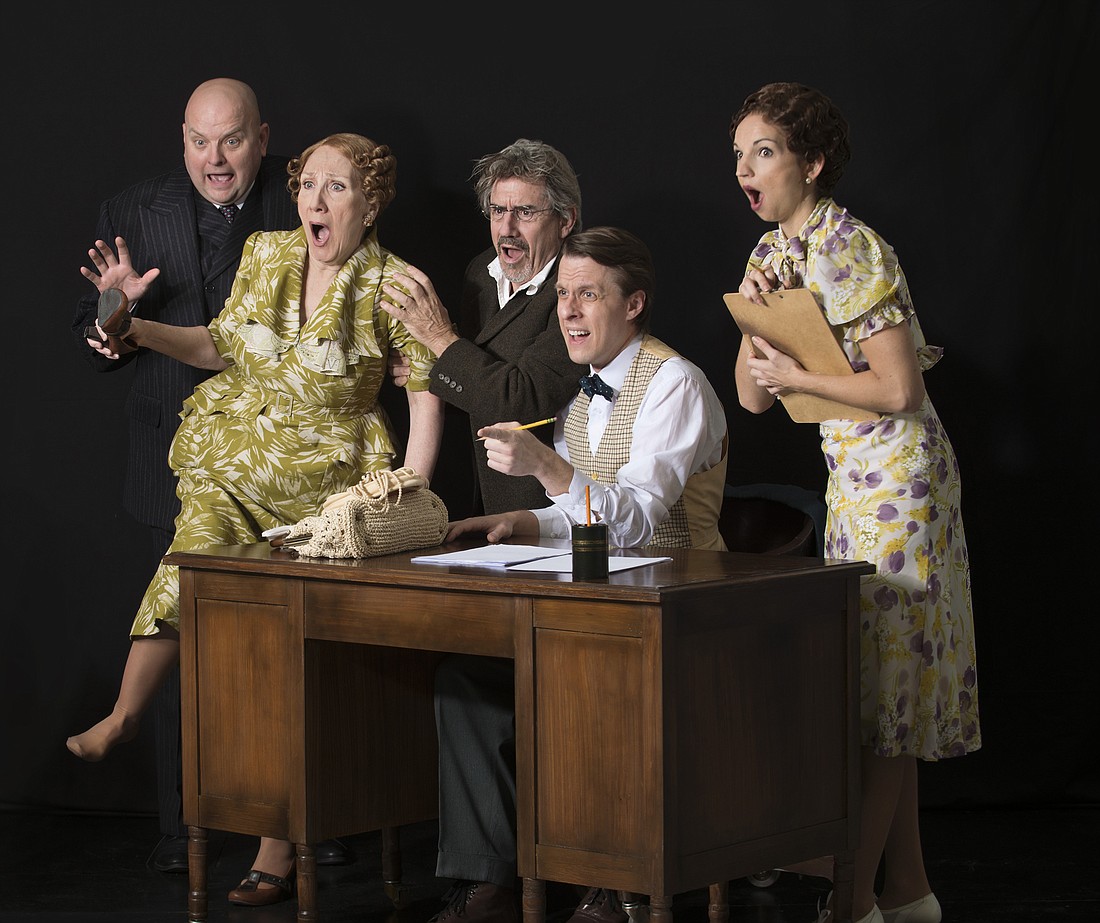- December 19, 2025
-
-
Loading

Loading

Eugène Ionesco’s “Rhinoceros” has thundered onto the Asolo Rep stage — a whole crash of them, actually. That’s a strange habitat for roaming rhinos, but shed no tears. In Ionesco’s 1959 absurdist comedy, man is the endangered species.
Sheer lunacy. In Ionesco’s typical style, madness slowly emerges from the mundane, then gradually takes over. Before you know it, insanity rules.
The play opens in a nameless French village. Two friends meet at an outdoor café. Gene (Matt DeCaro), a pompous, bourgeoisie know-it-all, berates his shabby, drunken pal, Berenger (David Breitbarth). Chums chat, waitresses wait, delivery boys deliver. Ordinary life does its ordinary thing. Until a loud, rumbling noise grabs the Villagers’ attention. (“Why … it’s a rhino! You don’t see that every day!”) The rhino finally leaves; the tidal pull of habit returns. After discussing the validity of perception and the rhino’s origin, the Villagers get back to business. They try to put the whole “rhino” incident behind them. If it ever even happened.
But it did. And the rhino returns. This time, it’s not alone. The new rhinos aren’t escapees from a traveling circus, either. They’re former people. One by one, the Villagers are slowly mutating into them.
That’s bad, right? Your typical zombie movie situation?
You’d expect reactions of shock, horror and panic. But no. The Villagers ignore the rhino in the room. They act like it’s no big deal. “The rhinos will go away; we can get used to them; who’s to say humans are superior?”
Berenger is the only one who seems to care. The rhinos horrify him. His neighbors’ blasé indifference horrifies him more. Especially when they all start sprouting horns and crashing through the streets.
Ionesco’s absurdist play occupies a weird space. Part horror, part hilarity. As if the Marx Brothers popped out of a time machine and did a remake of “An American Werewolf in Paris.”
Director Frank Galati plays it for laughs, but doesn’t sugarcoat the monstrosity. It’s a nightmare situation. Galati grabs you with both hands and pulls you into Ionesco’s bad dream. His direction is strong, but it’s easy to miss one of his key strengths.
The text is Derek Prouse’s 1960 translation. A serviceable work, quite literary — but on the page it reads like a translation. Yet, Galati manages to make the words flow with the cadences of natural English speech. That’s a combination of good direction and good editing. With the blessings of Ionesco’s estate, Galati streamlined the play. The tighter version flows with crisp dramatic pacing. It’s quite an achievement.
Breitbarth’s Berenger is the hero of the play, but only by default. He’s just an ordinary slob, not a steely-eyed superman. His vulnerable humanity moves us — especially in contrast to the thick-skinned beasts going wild in the streets. It’s an outstanding, underplayed performance. And heartbreaking as he’s left more and more alone. One by one, his friends and co-workers turn. Berenger’s boss, the clockwatching Mr. Papillion (Matthew McGee) is the first to go, quickly followed by his loyal wife (Peggy Roeder). (McGee is also hilarious belting out Edith Piaf classics in a dual role in drag.) The irrational Botard (Brandon Dahlquist) goes next; the rational Dudard (Matt Mueller) holds out much longer. DeCaro’s Gene reminds me of Daumier’s etching of a smug, bourgeoisie banker. He’s full of himself, but basically a nice guy. Berenger fights to stop his best friend’s long, slow transformation. The scene’s funny at first — then agonizing. Laura Rook’s Kitty (Berenger’s secret love) might help him repopulate the world, but don’t hold your breath.
Robert Perdziola brings Ionesco’s dark dream to life with a one-two punch of creativity. His period costumes are befittingly banal. His scenic design ranges from bright, happy backdrops (a charming boulevard straight out of a Maurice Utrillo painting) to the massive, hulking rhinoceros lurking at the back. Chris Ostrom’s lighting is appropriately surreal—with plenty of shadows and fog.
This edgy, risky production wisely avoids the standard “Let’s put the actors in papier-mâché rhino heads” approach. Except for one brief, dimly lit procession in the final scene, the rhinoceri stay off-stage and out-of-sight. Galati wisely lets you imagine the horrors. (As “Jaws” taught us, the monster you can’t see is always more terrifying.) You hear them, though. The thundering, pulsing bass of Joe Cerqua’s sound design creates a bone-deep sense of menace.
So there’s a fear factor. But the humans aren’t merely victims. They’re responsible for the fearful change.
Ionesco never spells it out, but the rhinovirus isn’t spread automatically. To become a rhino, you’ve got to want it. With the exception of Berenger, the Villagers all do.
Before transforming into pachyderms, the Villagers fall under the spell of pro-rhino publicity. “Humans are thin-skinned, pitiful and weak. Rhinos are the future! A future of speed, strength, instinct, action and pitiless power!”
The admiring adjectives are straight out of a pro-fascist pamphlet from the 1930s. No coincidence, obviously. When Ionesco penned this play, the wounds of the black shirts and brown shirts were still fresh. The Iron Guard of his native Romania. The Nazi thugs (and willing collaborators) who occupied France. The playwright remembered those beasts in human skin. And poured his white-hot anger into the script.
“Rhinoceros” is rooted in a specific time. It’s equally timeless and timely. Ionesco’s rampaging rhinos stand for conformist human herds of all varieties. Those on the Right can enjoy a cautionary tale about the herds of the politically correct. Those on the Left will appreciate a prophecy of Trump’s stampeding supporters. The bad guys are always the other guys, right?
When leaving the theater, be sure to check your forehead for a budding horn.